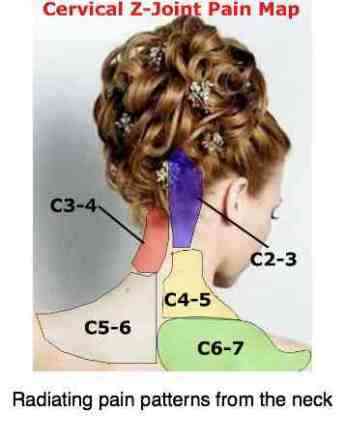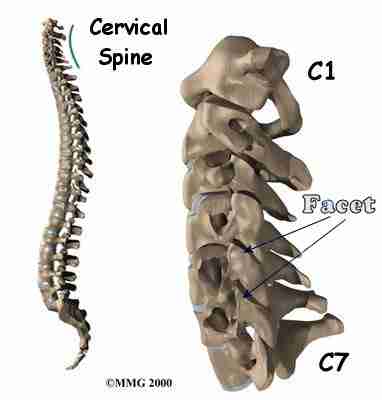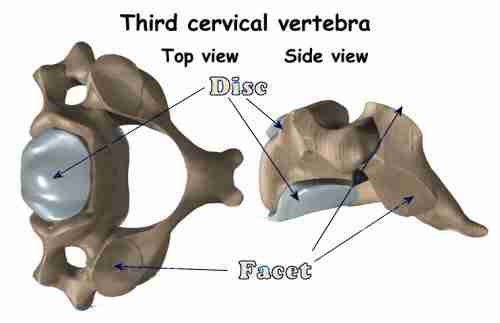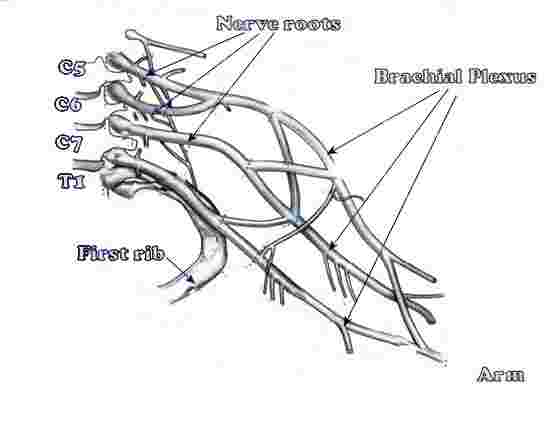Cervical Facet Syndrome
A common complaint after whiplash
Keyword; cervical facet syndrome, chiropractic help, atlanto occipital joint.
This neck pain condition faces the chiropractic physician on a daily basis. Neck pain, headache and, less commonly, pain or tingling radiating down the arm, but more frequently to the region between the shoulders.
The cause? Quite simply, trauma, and sometimes poor posture. For example sleeping on your stomach. For years medicine has been in denial that whiplash, and other related trauma, can and frequently does cause injury to the various tissues in the neck. In a 10 year follow up study after whiplash, only 12 percent of the victims reported that they had absolutely no symptoms and had healed completely.
In another study reported in Spine, a prominent medical journal, fully 60 percent of whiplash patients were found to be suffering from a Cervical Facet Syndrome.
There is oodles of research now on whiplash, done by a whole range of specialists, chiropractic, orthopedic, neurological and radiological confirming the importance of the Cervical Facet Syndrome.
Cervical Facet Syndrome
The vertebrae, the ligaments, the muscles, the nerves, the discs and the facets (aka Z-joints) are all vulnerable to whiplash. Other more nebulous tissues too, like the fascia, of course the cord itself, and the blood vessels. Now there is overwhelming evidence that whiplash does cause permanent injury, and the cervical facet syndrome is one of the most traumatised tissues.
SYMPTOMS
The facet joints in the neck have quite different shapes and orientations depending on their location, so the presentation varies quite dramatically according to which facet is involved. Very broadly, and frankly this is an over-simplification, we can divide the cervical facet syndrome into four different types:
The facet joints in the neck have quite different shapes and orientations depending on their location, so the presentation varies quite dramatically according to which facet is involved. Very broadly, and frankly this is an over-simplification, we can divide the cervical facet syndrome into four different types:
The Atlanto Occipital joint (C0-C1)
These two joints, right and left, lie between the base of the skull known as the occiput; and the first bone in the neck, called the atlas. Hence the name atlanto occipital joint. It is at this joint that nodding movements of the skull on the neck occurs; small up and down movements, adjusting the head position in relation to the monitor in front of you, for example.
Subluxation of these joints causes a deep ache at the very top of the neck, often causing severe headaches. A large artery supplying the base of the brain winds it's way around this joint.
Chiropractic help uses a variety of techniques including manipulation; the Chiropractic adjustment. Sometimes the atlanto occipital joint is the problem; or that at the atlanto axial level.
Subluxations of this joint can cause widely differing symptoms such asvertigo and loss of balance. Medically this is often causes a condition called benign positional paroxysmal vertigo, and sometimes Meniere's disease, if it there is associated deafness and ringing in the ear. However, in my experience, Meniere's is often wrongly diagnosed, the cause being either at this joint, or that condition in the inner ear, called BPPV that is very treatable with new techniques called the Epley Maneuver; this is a short course for chiropractors wanting to learn the Epleys.
Atlanto Axial joint anatomy (C1-C2)
These joints are quite different to C0-C1. It is here that most of the rotation of the neck occurs. Subluxations of the atlas are one of the causes of a severe stiff neck, often associated with headache too.
C2-C3
This joint has no specific name (as C3 as no name). However, it is possibly the most commonly subluxated joint in the neck. (Chiros will argue vociferously about that!) It too can cause headaches and a very stiff neck called a Torticollis. Pain!
See those 'facet joints'? They are lined with glistening white hyaline cartilage. When healthy it's very hard but, because it has no blood supply, it's very dependent on certain physiological factors for health and restoration after injury. The alternative is arthritis, stiffness and pain.
Chiropractic help for Lower neck and arm pain
(C4-T1)
Facets in the mid-to-low cervical spine again are rather different in orientation and also, by virtue of the fact that the nerves emerging from the region supply the shoulder and arm, the Cervical Facet Syndrome presents rather differently.
Thus headache is less of a feature in this region. Rather, the fixations cause stiffness of the neck, and associated tightness and pain in the shoulder muscles.
Just adjacent to the facets, small joints often injured in whiplash are found.
TMJ anatomy
Because the sensory Trigeminal nucleus of the nerve supplying the jaw joint is found in the upper neck, in the region C1-C3, sensory information from the cervical facets feeding into that same nucleus, neck pain andjaw joint pain (TMJ) often go hand in hand.
Between them, the cervical facets and the TMJs are the major cause of blinding Migraine headaches, though it must be recognised there are many causes of migraine. For more about headache in general, and the association between the TMJ and migraine, click here.
ARM PAIN
The whole arm becomes vulnerable.
The nerves emerging from this region supply the shoulder and arm. Should there be nerve involvement then the pain, tingling and numbness may spread into the arm, causing obscure arm pain and making you will be vulnerable to shoulder pain, conditions such as
Take note of the first rib in the diagram above. A fixated rib is the most common cause of the so called Thoracic Outlet Syndrome which can affect the artery supplying the arm, and the nerves. Working with your hands above your head, as in hanging the washing, or using a drill above shoulder level, makes your arm tired very quickly.
To understand the low cervical facet syndrome properly you need to have some grasp of the low cervical facet anatomy.
The the basis of your arm pain be a pinched or irritated nerve in the neck? The basic test for a pinched nerve in the neck is known as the upper limb tension test




Nenhum comentário:
Postar um comentário